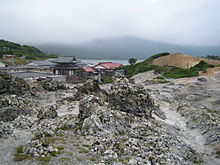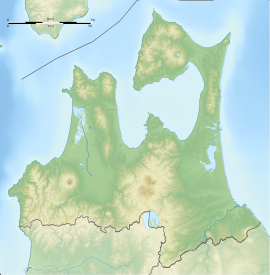Mount Osore
| Osore-zan Bodai-ji | |
|---|---|
 Grounds of Bodai-ji | |
| Religion | |
| Affiliation | Buddhism |
| Sect | Sōtō Zen |
| Deity | Jizō Bosatsu |
| Location | |
| Location | 3-2 Tanabu Usoriyama, Mutsu-shi, Aomori-ken |
| Country | Japan |
| Geographic coordinates | 41°19′37.39″N 141°5′24.97″E / 41.3270528°N 141.0902694°E |
| Architecture | |
| Founder | Ennin |
| Date established | 862 |

Mount Osore (
Etymology
[edit]The name originally comes from the Ainu language, with the form later phonetically changed when borrowed into the Japanese language to match the Japanese word osore (
Mount Osore volcano
[edit]The mountain is one peak of the Osore-zan Mountain Range (
During the Meiji period, sulphur deposits in the area were exploited, partly to meet the demand for gunpowder production by the growing Japanese military; however the deposits were not economical to mine due to the remoteness of the site and the increasing availability of sulphur as a byproduct of petroleum refining.
Bodai-ji temple and pilgrimage location
[edit]The mountain is the location of a Sōtō Zen Buddhist temple, Bodai-ji (
A unique feature of Bodai-ji is the presence of mediums known as itako who claim to summon the souls of the dead and deliver messages in their voices. These mediums were traditionally blind and had to receive extensive spiritual training and purification rituals; however, in modern times, their number has dwindled and not all are blind. The temple has a twice-yearly Itako Taisai festival held in summer and autumn.
The temple also maintains a hot spring resort for use by pilgrims and tourists.
In modern culture
[edit]The work of contemporary artist Nara Yoshitomo, who is a native of Aomori Prefecture, is believed to be influenced, at least subconsciously, by Mount Osore (Ivy, 2010). For instance, his piece entitled “Not Everything But/ Green House” depicts a small female child standing over a pile of discarded dolls of varying characteristics and eras much like those observed at Mount Osore.[10]
As part of a collection of fictional fungi, artist Takeshi Yamada created the Oh-dokuro-dake (or “skull mushroom”) and the story surrounding their presence on Mount Osore for his "center for medical mycology" art project.[11]
Gallery
[edit]-
Sōmon gate of Bodai-ji
-
Sammon gate of Bodai-ji
-
Lake Usori
-
Effigy of a child
Notes
[edit]- ^ a b Chris Bamforth (22 December 2006). "Mountain of dread". The Japan Times. Retrieved 10 February 2020.
- ^ a b "
恐 山 (Osore-san)". Nihon Jiten (in Japanese). 2017. Retrieved 21 August 2024. - ^ John Batchelor (1905). "ush-oro". An Ainu-English-Japanese dictionary (including a grammar of the Ainu language). Retrieved 21 August 2024.
- ^ John Batchelor (1905). "usat". An Ainu-English-Japanese dictionary (including a grammar of the Ainu language). Retrieved 21 August 2024.
- ^ John Batchelor (1905). "oro". An Ainu-English-Japanese dictionary (including a grammar of the Ainu language). Retrieved 21 August 2024.
- ^ John Batchelor (1905). "nupuri". An Ainu-English-Japanese dictionary (including a grammar of the Ainu language). Retrieved 21 August 2024.
- ^ The Smithsonian Museum of Natural History states that an eruption occurred in 1787, but this is not corroborated by Japanese sources
- ^ "Osore Zan". Geological Survey of Japan. Retrieved 6 June 2020.
- ^ "About Mount Osore - Aomori Travel Guide | Planetyze". Planetyze. Retrieved 2017-11-08.
- ^ A picture of this piece while at the Marianne Boesky Gallery in March 2009 may be seen here.
- ^ "Takeshi Yamada, Art & Rogue Taxidermy, Center for Medical Mycology in Coney Island, Brooklyn, New York, Contact, takeshiyamadaart@gmail.com - TAKESHI YAMADA Art & Rogue Taxidermy". Archived from the original on 2015-06-26. Retrieved 2015-06-26.
References
[edit]- Fackler, M. (2009, August 20). As Japan's mediums die, ancient tradition fades. The New York Times, p. 8, Retrieved from https://www.nytimes.com
- Global Volcanism Program. (n.d.). Osore-yama. Retrieved from http://www.volcano.si.edu/world/volcano.cfm?vnum=0803-29=
- Ivy, M. (2010). The art of cute little things: Nara Yoshitomo's parapolitics. Mechademia, 5(1), 3-29. doi:10.1353/mec.2010.0020
- Wonderland Japan WAttention. (n.d.). Mt. Osore. Retrieved from https://www.webcitation.org/6Bp5xzjwO?url=http://www.wattention.com/archives/mt-osore
- Yamada, T. (2011, June). Skull mushroom. Retrieved from https://www.flickr.com/photos/museumofworldwonders2/5725108088






